ISSN
2307–3489 (Print), ІSSN
2307–6666
(Online)
Наука
та прогрес транспорту. Вісник
Дніпропетровського
національного університету залізничного
транспорту, 2016,
№
6
(66)
економіка
та управління
UDC
338.45:656.225
B.
FARKAS1*,
1*Dep.
«Faculty of Transportation Engineering and Vehicle Engineering»,
The Budapest University
of Technology
and Economics, Műegyetem rkp. 3, Budapest, Hungary, H-1111, tel. +36
1 (463) 10 51,
e-mail
farkas.balint@mail.bme.hu, ORCID 0000-0001-5388-9905
PRESENTATION OF
THE RAIL FREIGHT
MARKET’S CONCENTRATION WITH
RESPECT TO THE GAS
MARKET
WITH THE HELP OF THE HERFINDAL-
HIRSCHMAN INDEX
Purpose. To
demonstrate the current level of concentration on the rail freight
market and to find a feasible long-term way for its expansion and
progress by exploring and comparing it to another industrial branch
well ahead on the road of concentration. Methodology. To
identify an industrial branch being at an appropriate level of
concentration, therefore being suitable for the purpose. To adapt the
Herfindahl-Hirschman Index (HHI) for measuring the level of
concentration of the market. Finally, to make a series of comparisons
between the levels of concentrations of the two markets. Findings.
In terms of concentration of the market, the
liberalisation was more successful in the gas sector than in
the rail freight sector, in Hungary. Therefore, the Hungarian gas
sector is to be abandoned for comparison purposes and another, more
suitable should be picked. Figures in the charts and findings of the
application of the HH Index demonstrate that the
liberalisation process in the energetics sector in Estonia has
been most efficient. The methods of the Estonian process may be
applicable for reducing the level of concentration on the rail
freight market in Hungary. Originality. Novelty as far as the
application of the Herfindahl-Hirschman
Index for the purposes of the investigation is concerned. An
innovative approach to analyse the
structure of the rail freight market by a test, which has been unique
so far in Hungary. Practical value. By using a mathematical
method, a market suitable for testing can be selected. The results of
the analyses can be adopted for the purposes of the rail freight
market.
Keywords:
rail; gas; market; liberalization; Herfindahl-Hirschman Index;
freight
Introduction
In this paper we point out that
compared to other sectors ahead with the liberalization, the degree
of liberalization of rail freight can be defined. A possible way to
this comparison is the application of the Herfindahl-Hirschman Index
(hereinafter HHI). The HHI index shows the concentration of the
market, the lower the value the more liberalized the particular
market is. Our study will show that the liberalization of rail
freight cannot be considered satisfactory. To find a solution to
this problem, the method to be applied is that we examine the
liberalization processes of industries showing similarities to rail
freight with other, specific characteristics [14].
We will select an industry based
on some of the important features, and examine its process of
liberalization to receive guidance in the future on how the
liberalization of Hungarian rail freight can be made. In our article
we examine the natural gas service among the industries, and we will
compare this the rail freight on the basis of the HHI index. We will
introduce the HHI index, its forming’s mathematical method, and
what consequences can be drawn from it regarding the degree of
liberalization. Then we will determine the HHI index of the natural
gas industry and the rail freight. Based on this data we will point
out the differences and tendencies in numbers and draw conclusions.
The purpose of research.
The Hungarian rail freight as well as a number of other services
should be liberalized. One reason is that the liberalized market
creates the conditions for that the quality, the performance and the
low price should mean the competitive edge and not the speculative
instruments and the abuse of a dominant market position [1]. This is
the interest of the sector as it contributes to development, and
also the interest of the consumers as they can enjoy higher value
services with more choice besides a better price-performance ratio.
Because of all these reasons the
European Union (hereinafter EU) also provides directives for the
liberalization to the legislators. These directives are 91/440/EEC,
95/19/EK, «First Railway Package» (2001), «Second Railway
Package» (2004), «Third Railway Package» (2007), «Forth Railway
Package» (2013) [4]. These directives have gradually prescribed the
advancing of the liberalization process. The liberalization of
Hungarian rail freight has already begun, but not yet complete. The
long-term goal of our research is to find a solution to the question
of how the liberalization of Hungarian rail freight sector can be
continued [10]. For this we chose the method to examine the process
of liberalization in other industries which are already ahead of or
even been liberalized on an acceptable level [5].
The method. In this paper
we deal with that how to select the example industry, which industry
should we consider sample to find guidance to the further
liberalization of Hungarian rail freight. For this in the first
round we should find such industries, which are more similar to rail
freight with regard to characteristics. Such common characteristics
are, for example, that we talk about a service, which is associated
with a physical network, which network is multi-level depending on
how large area it covers. If we had found the market with these
characteristics, we would have needed to choose the most suitable
among them. We also judge this suitability with the degree of
liberalization, because only then we can conclude that the choice
described above is ahead to the liberalization process, that is,
whether we can draw progressive lessons from it? We determined the
degree of liberalization by using HHI. In this paper we are moving
forward in the above-described steps.
Choosing the appropriate
industry. The service sector similarly networked as rail, the
other infrastructure sectors, namely drinking water supply, natural
gas supply, district heating and electricity services [8]. There is
no nationwide network of district heating, but only local, so we can
ignore this sector. The remaining three has national and
international level as well. Among them the natural gas service has
both regional and national, and also international level, so we find
this sector suitable for further analysis, which determines the
degree of liberalization by using HHI [2].
Presentation
of Herfindahl-Hirschman Index (HHI).
The Herfindahl-Hirschman Index shows how
concentrated a particular market is, that is how well its shares are
distributed among the participants [3]. The more even the share of
the market participants is, the smaller the HHI is, and in case if
less participants have more shares, then the HHI will be higher. Its
forming is done by the sum of squares of the market operator’s
shares:
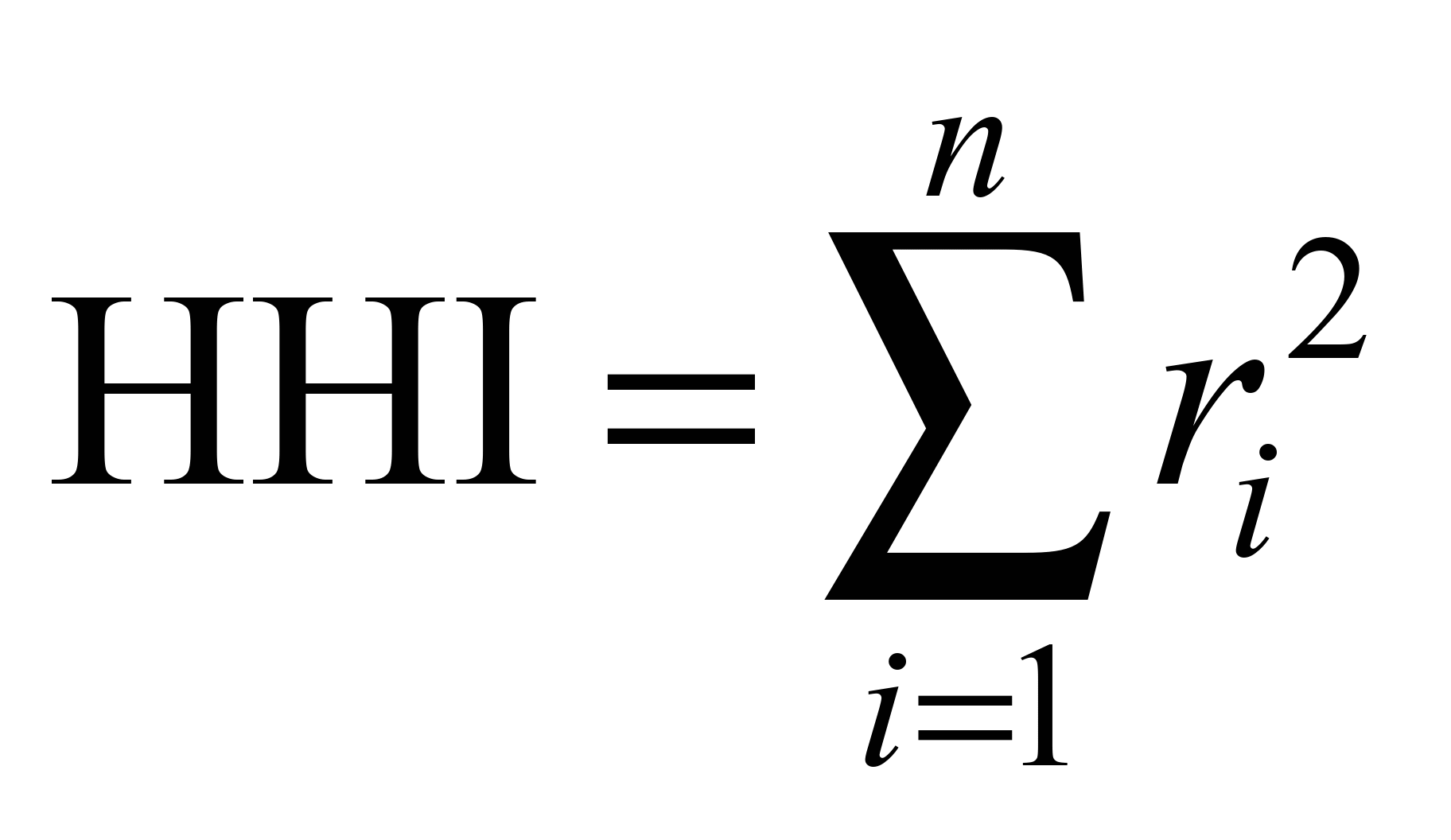 ,
,
where
 the
number of market operators;
the
number of market operators;

the share of
the share of
 operator.
operator.
Its value is
between
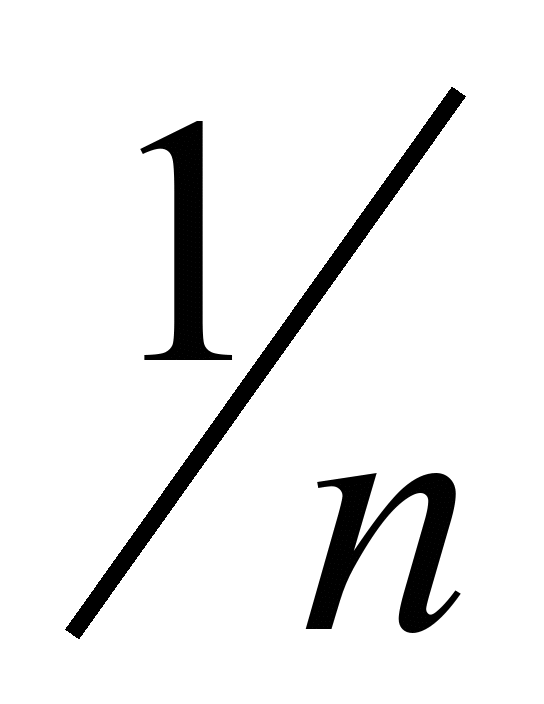 and 1, or it is also usual to substitute
and 1, or it is also usual to substitute
 with the number value of percentages, then the upper threshold is
10000, this is more expressive.
with the number value of percentages, then the upper threshold is
10000, this is more expressive.
We distinguish three levels of
classification of the markets’ concentration based on the HHI:
According to the US
classification:
– Non-concentrated
market: HHI below 1 500
– Less
concentrated market: HHI between 1 500 and 2 500
– Highly
concentrated market: HHI above 2 500
According to the Hungarian
classification:
– HHI below
1 000 – non-concentrated market
– HHI
between 1 000 and 1 800 – less concentrated market
HHI above 1800 – highly
concentrated market [12].
Presentation
of the calculation and its results. In
the following diagrams (see Fig. 1, Fig. 2,
Fig. 3, Fig. 4, Fig.
5, Fig. 6, Fig. 7, and Fig. 8) we can see the companies’ market
share of the natural gas service and the rail freight market. In the
following diagrams the letters are the names
of the rail freight market actors in Hungary (A, B, C, ...). The
figures show the percentage share calculated in freight ton-km
basis. After the graphics presenting the
certain years, in summary we will illustrate the evolution of HHI in
terms of rail freight and natural gas service, in the period from
2010 and 2015.
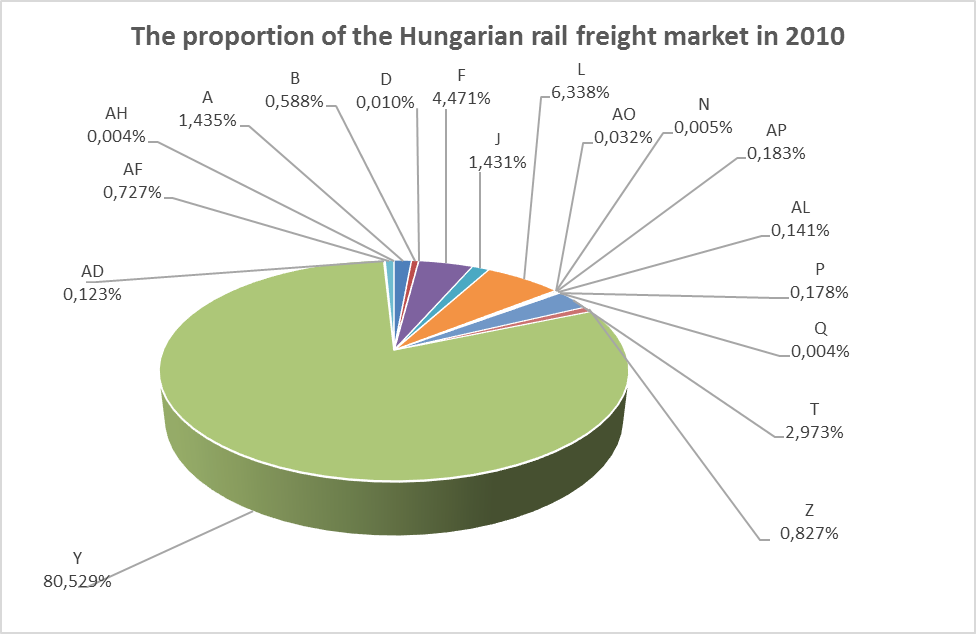
Fig. 1. The
proportion of the Hungarian rail freight market in 2010
Source:
own work (National Transport Authority)
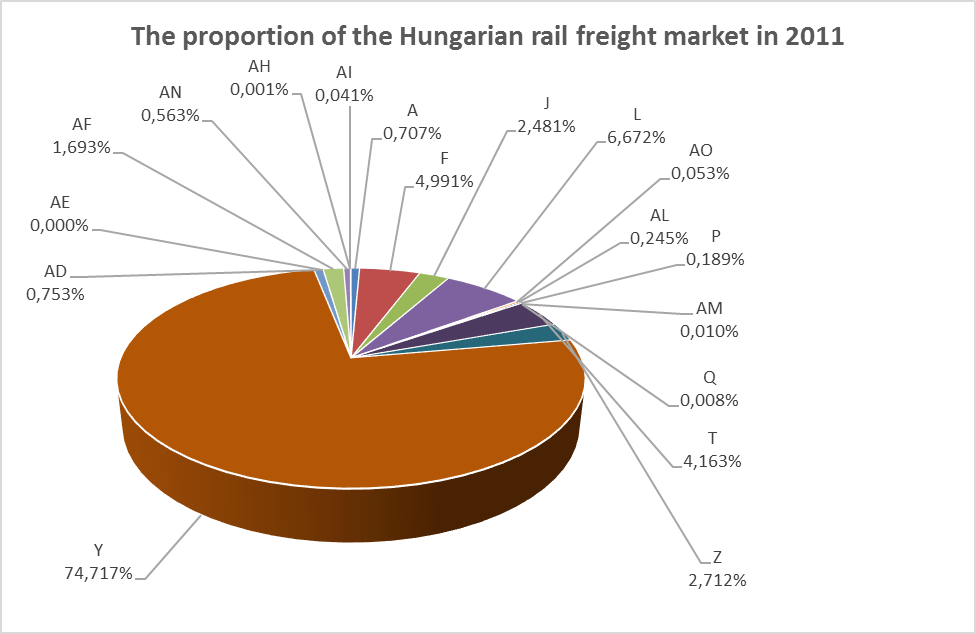
Fig. 2. The
proportion of the Hungarian rail freight market in 2011
Source:
own work (National Transport Authority)
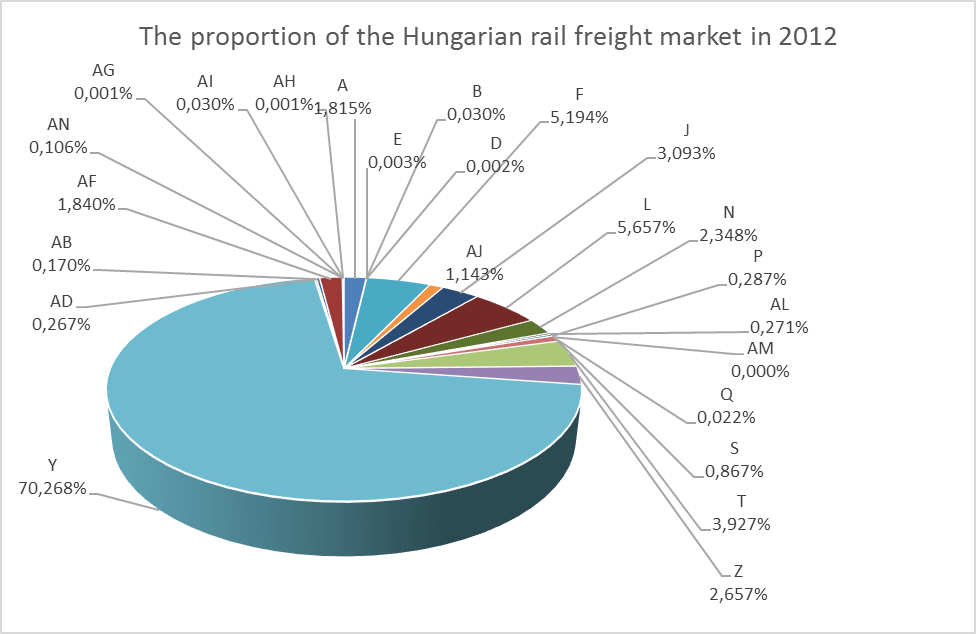
Fig. 3. The
proportion of the Hungarian rail freight market in 2012
Source:
own work (National Transport Authority)
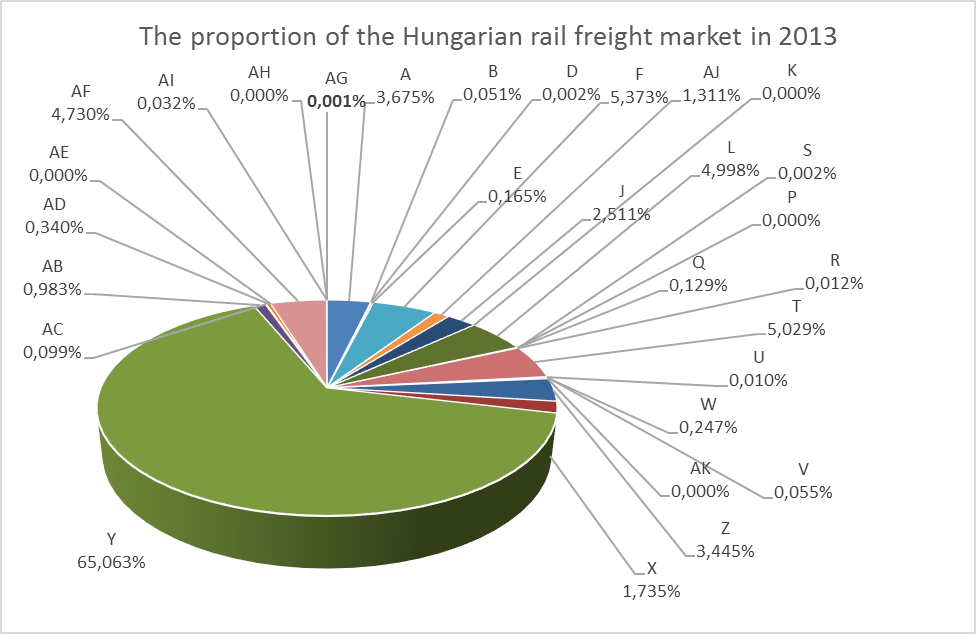
Fig. 4. The
proportion of the Hungarian rail freight market in 2013
Source:
own work (National Transport Authority)
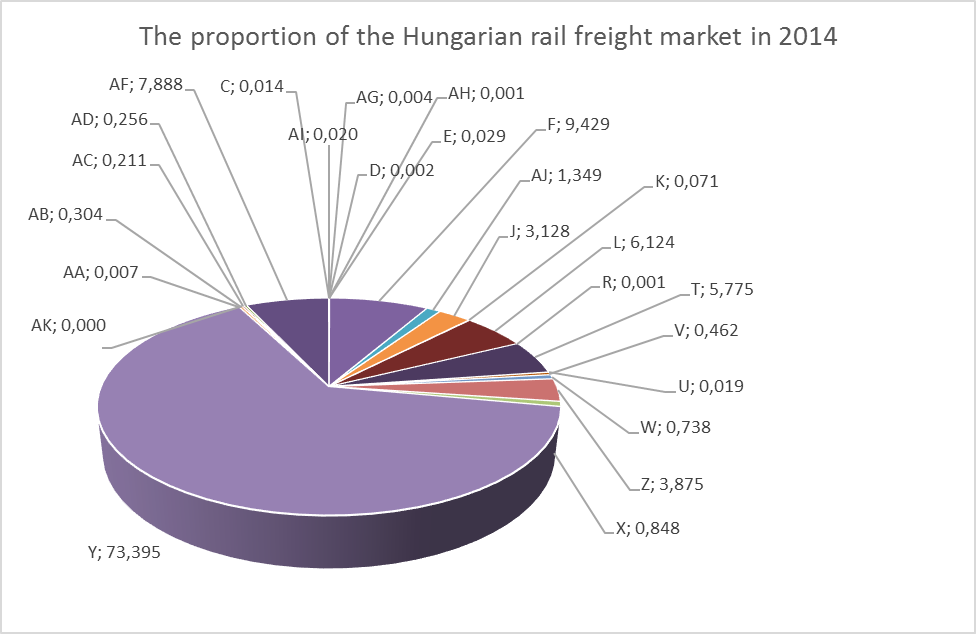
Fig. 5. The
proportion of the Hungarian rail freight market in 2014
Source:
own work (National Transport Authority)
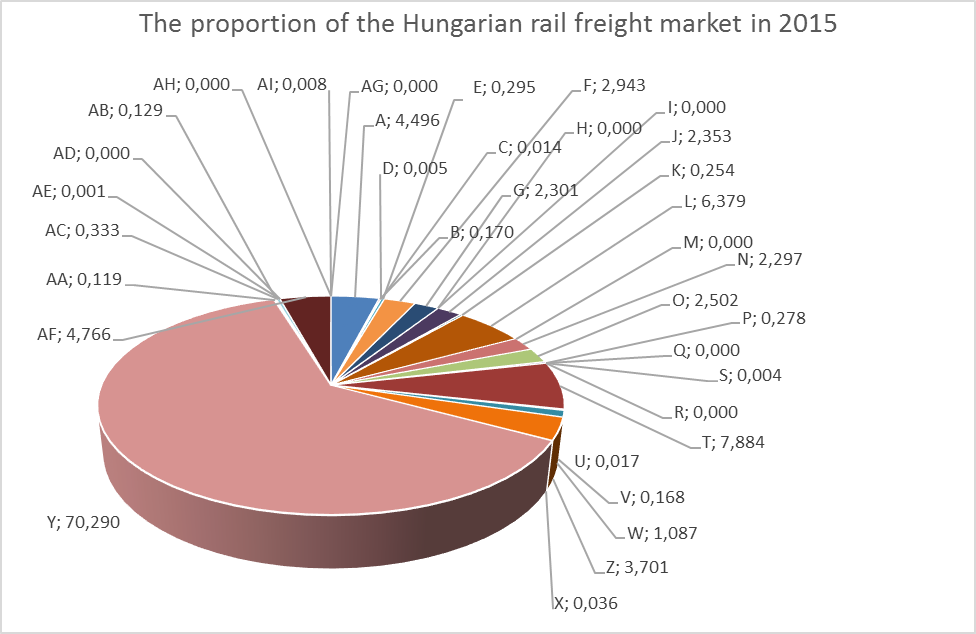
Fig. 6. The
proportion of the Hungarian rail freight market in 2015
Source:
own work (National Transport Authority)
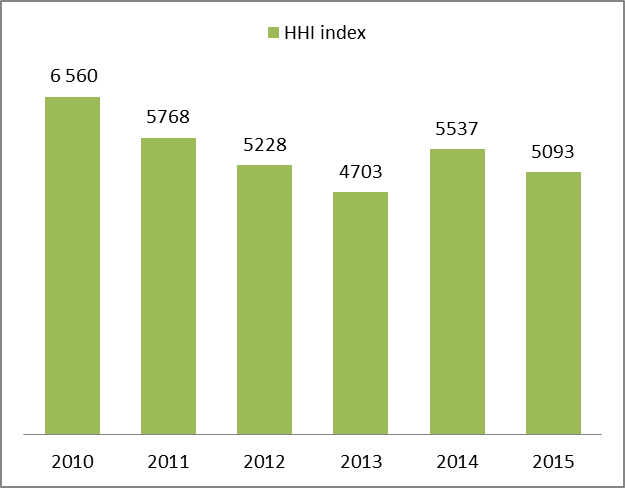
Fig. 7. The HHI
indexes of the Hungarian rail freight from 2010 to 2015 broken down
by years
Source: own work (National Transport Authority)
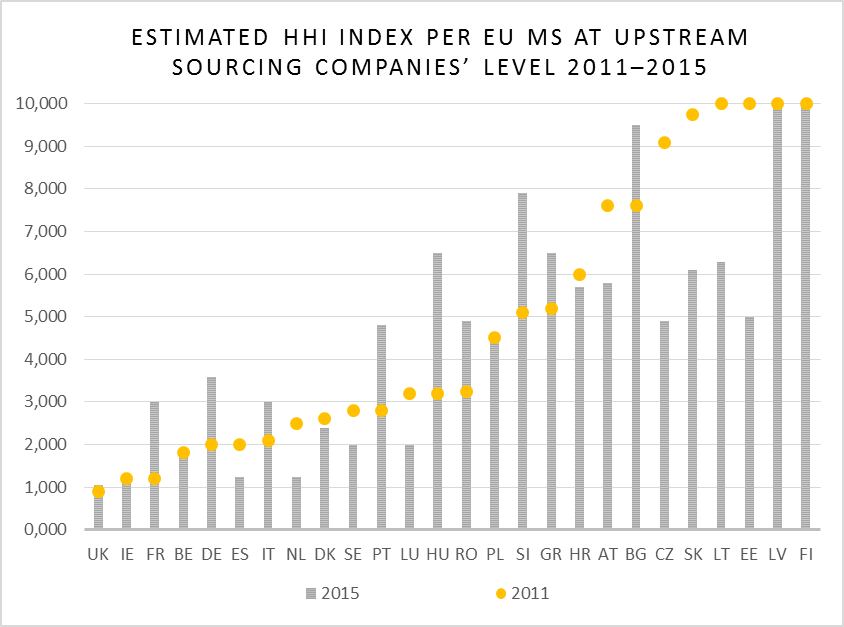
Fig. 8. The HHI
index of the European countries’ gas trade and market in 2011 and
in 2015
Source: ACER calculations based on Eurostat and Eurostat
Comext, BP Statistical Report, Frontier Consultancy desktop research
for GTM 2014 and NRAs data. (See annex 1 for methodology
clarification)
Rail
freight. The HHI index of rail freight
fluctuated between 4500 and 7000 in the period from 2010 to 2015
(Chart 1-6), showed a clear decrease until 2013 and then began to
rise (Chart 5). With these HHI indexes, unfortunately, the rail
freight market is in the «highly concentrated» category. This is
because the share of one of the market operators is overwhelming,
this company’s share affected the tendencies the most. From this
it is visible that the circle of market operators has steadily
expanded, this has not significantly improved the concentration of
the market since new entrants hold only a small share of the market.
The liberalization process is not satisfactory, the market
competition’s conditions of fair, quality and performance based,
serving the interest of the consumers in the long run are not met.
Natural gas service. From
Chart 9 can be concluded that Hungary had the largest increase in
market concentration from all EU Member States [13]. In Estonia,
however, it shows that it came back nearly 50% from the highest
concentration [6]. This is because of the good differentiation, the
choice of good product range and good economic decisions [9, 15].
Conclusions
All these show that the
liberalization of Hungarian rail freight still intends to continue.
The structure of the market is required to be homogenized to comply
with European Union directives and to make passible the development
of a healthy market competition bearing in mind the interest of
consumers. As a result of our research we can see that the
liberalization efforts have not been sufficiently successful in the
natural gas supply market [7]. By taking into account this and the
previous considerations, it can be said that it is not worthwhile
examine how the liberalization of this industry has been implemented
in Hungary. Instead, we must seek for another, more suitable example
of industry hereinafter. Or further studies would be necessary in
the energy liberalization of Estonia, because as the above figure
shows, Estonia could reduce its market concentration very well. As
another direction of our research, we will examine the gas industry
market and position of Estonia.
LIST OF REFERENCE LINKS
Bethlendi,
A. A hazai hitelpiac empirikus vizsgálata fejlődési irányok,
makrogazdasági és pénzügyi stabilitási következmények
:
PhD thesis / A. Bethlendi ; Budapesti Műszaki és
Gazdaságtudományi Egyetem Gazdálkodás- és Szervezéstudományi
Doktori Iskola.
–
Budapest, 2009. – P. 22–31.
Bointner,
R. Knowledge
in the energy sector: what R&D Expenditures and patents reveal
about innovation [Vortrag] / R. Bointner // 38th
IAEE Intern. Conf. (25.05–27.05.2015).
–
Türkei, Antalya, 2015. – P. 2.
Cutler,
D. M. Hospitals, Market Share, and Consolidation / D. M. Cutler, F.
S. Morton // JAMA. – 2013. – Vol. 310. – Iss. 18. –
P. 1964–1970. doi:10.1001/jama.2013.281675.
Duleba,
S. An Analysis on the connections of factors in a public transport
system by AHP-ISM / S. Duleba, Y. Shimazaki, T. Mishina //
Transport. – 2013. – Vol. 28. – Iss.
4. – P. 404–412. doi: 10.3846/16484142.2013.867282.
Gregor,
G. Generation Investments under Liberalized Conditions in the
Central and South-East European region / G. Gregor, A. Kiss,
A. Mezősi // Security of Energy Supply in Central and South-East
Europe / ed. P. Kaderák. – Budapest : REKK, 2011. –
P. 150–201.
Liberaliasation
of the Estonian Gas Market: A report to Elering AS [Electronic
resource]. – Oxford : Pöyry Management Consulting, 2011. – 154
p. – Available at:
http://www.poyry.com/sites/default/files/573_estonian_liberalisation_v1_0.pdf.
– Title from the screen. – Accessed : 04.10.2016.
Kiss,
A. Measures and Indicators of Regional Electricity and Gas Supply
Security in Central and South-East Europe / A. Kiss, A. Mezősi,
A. I. Tóth // Security of Energy Supply in Central and South-East
Europe / ed. P. Kaderák. – Budapest : REKK, 2011. – P. 8–51.
Kurmai,
V. A piaci verseny és koncentráció az almasűrítmény
világpiacán / V. Kurmai // Agrártudományi Közlemények. –
2016. – Iss. 69. – P. 129–133.
Ripple,
R. D. Global Natural gas markets: Prospects for US exports?
[Electronic resource] : presentation / R. D. Ripple // EIA Energy
Conf. (15.06–16.06.2015) / The University of Tulsa. –
Washington, 2015. – Available at:
https://www.eia.gov/conference/2015/pdf/presentations/ripple.pdf.
– Title from the screen. – Accessed : 03.01.2017.
Smith,
A. S. J. The Impacts of Economic Regulation on the Efficiency of
European Railway Systems / A. S. J. Smith, V. Benedetto,
C. A. Nash // 4th
White Rose Doctoral Training Centre Economics Conference
(27.03.2015) / University of Leeds. – Leeds, 2015. – P. 5.
Sugár,
A. A piacszabályozás elméleti és gyakorlati aspektusai
közszolgáltató szektorokban, elsősorban az energiaszektor
árszabályozása példáján : PhD thesis
/ A.
Sugár. –
Budapest
: Corvinus University of Budapest, 2011. – 27 p.
Uhrin,
G. A verseny intenzitásának mérhetősége [Mensurability of the
competition’s intensity] [Electronic resource] / G. Uhrin. – 40
p. – Available at:
http://www.gvh.hu/data/cms1000455/Uhrin%20G%C3%A1bor.pdf. – Title
from the screen. – Accessed : 05.10. 2016.
Vandewalle,
J. Natural gas in the energy transition. Technical challenges and
opportunities of natural gas and its infrastructure as a
flexibility-providing resource : Dissertation / J. Vandewalle.
– Leuven : KU, 2014. – 268 p.
Varga,
J. A versenyképesség többszintű elemzése az innovációval
való összefüggése : doktori (Ph.D) értekezés / J. Varga. –
Gödöllő : Szent István Egyetem, 2014. – 215 p.
Youngs,
R. The EU’s global climate and energy policies: gathering
momentum? / R. Young // FRIDE’s working papers. – 2013. –
№ 118. – P. 24. – Available at:
http://fride.org/download/WP_118_EU_global_climate_and_energy_policies.pdf.
– Title from the screen. – Accessed : 07.11.2016.
Б. Фаркас1*
1*Каф.
«Транспортное
машиностроение и автомобилестроение»,
Будапештский университет
технологий
и экономики, Műegyetem
rkp. 3, Будапешт , Венгрия,
H-1111, тел. +36 1 (463) 10 51,
эл.
почта farkas.balint@mail.bme.hu,
ORCID 0000-0001-5388-9905
ПРЕЗЕНТАЦИЯ
КОНЦЕНТРАЦИИ ГРУЗОВОГО
ЖЕЛЕЗНОДОРОЖНОГО
РЫНКА В ОТНОШЕНИИ
ГАЗОВОГО РЫНКА С
ПОМОЩЬЮ ИНДЕКСА
ХЕРФИНДАЛЯ-ХИРШМАНА
Цель.
Данная статья имеет своей целью
продемонстрировать текущий уровень
концентрации рынка железнодорожных
грузовых перевозок и найти целесообразный
постоянный способ его расширения и
продвижения, исследуя и сравнивая его
с другими промышленными отраслями,
которые достигли значительных успехов
на пути к концентрации рынка. Методика.
В работе необходимо: 1) определить
промышленную отрасль, находящуюся на
соответствующем уровне концентрации,
и, следовательно, пригодную для этой
цели; 2) адаптировать индекс концентрации
Херфиндаля-Хиршмана (ИХХ) для измерения
уровня концентрации рынка; 3) сделать,
наконец, ряд сравнений уровней
концентраций двух рынков. Результаты.
С точки зрения концентрации рынка в
Венгрии либерализация была более
успешной в газовой отрасли, чем в отрасли
железнодорожных грузовых перевозок.
Поэтому венгерскую газовую отрасль
следует исключить из сравнения и выбрать
другую, более подходящую. Цифры,
приведенные в таблицах, и результаты
применения ИХХ свидетельствуют о том,
что процесс либерализации в отрасли
энергетики Эстонии был наиболее
эффективным. Для снижения уровня
концентрации на рынке грузовых
железнодорожных перевозок в Венгрии
могут быть применены методы либерализации
Эстонии. Научная новизна.
В статье впервые рассматривается
применение индекса Херфиндаля-Хиршмана
для целей исследования. Используется
инновационный подход к анализу структуры
рынка железнодорожных грузовых перевозок
с помощью теста, который до сих пор был
уникальным для Венгрии.
Практическая значимость.
С использованием математического
метода можно выбрать подходящий для
тестирования рынок. Результаты анализов
могут использоваться для целей рынка
железнодорожных грузовых перевозок.
Ключевые
слова: железная дорога; газ; рынок;
либерализация; индекс Херфиндаля-Хиршмана;
грузоперевозки
Б.
ФАРКАС1*
1*Каф.
«Транспортне машинобудування і
автомобілебудування», Будапештський
університет
технологій
і економіки, Műegyetem rkp. 3, Будапешт,
Угорщина, H-1111, тел. +36 1 (463) 10 51,
ел.
пошта farkas.balint@mail.bme.hu, ORCID 0000-0001-5388-9905
ПРЕЗЕНТАЦІЯ
КОНЦЕНТРАЦІЇ ВАНТАЖНОГО
ЗАЛІЗНИЧНОГО
РИНКУ ЩОДО ГАЗОВОГО
РИНКУ ЗА ДОПОМОГОЮ
ІНДЕКСУ ХЕРФІНДАЛЯ-
ХІРШМАНА
Мета.
Дана стаття має за мету продемонструвати
поточний рівень концентрації ринку
залізничних вантажних перевезень та
знайти доцільний постійний спосіб його
розширення і просування, досліджуючи
й порівнюючи його з іншими промисловими
галузями, які досягли значних успіхів
на шляху до концентрації ринку. Методика.
У роботі необхідно: 1) визначити
промислову галузь, що знаходиться на
відповідному рівні концентрації, і,
отже, придатну для цієї мети; 2) адаптувати
індекс концентрації Херфіндаля-Хіршмана
(ІХХ) для вимірювання рівня концентрації
ринку; 3) зробити, нарешті, ряд порівнянь
рівнів концентрацій двох ринків.
Результати.
З точки зору концентрації ринку в
Угорщині лібералізація була більш
успішною в газовій галузі, ніж в галузі
залізничних вантажних перевезень. Тому
угорську газову галузь слід виключити
з порівняння та вибрати іншу, більш
відповідну. Цифри, наведені в таблицях,
і результати застосування ІХХ свідчать
про те, що процес лібералізації у галузі
енергетики Естонії був найбільш
ефективним. Для зниження рівня
концентрації на ринку вантажних
залізничних перевезень в Угорщині
можуть бути застосовані методи
лібералізації Естонії. Наукова
новизна.
У статті вперше розглядається застосування
індексу Херфіндаля-Хіршмана для мети
дослідження. Використовується
інноваційний підхід до аналізу структури
ринку залізничних вантажних перевезень
за допомогою тесту, який досі був
унікальним для Угорщини. Практична
значимість.
З використанням математичного методу
можна вибрати відповідний для тестування
ринок. Результати аналізів можуть
використовуватися для цілей ринку
залізничних вантажних перевезень.
Ключові
слова:
залізниця; газ; ринок; лібералізація;
індекс Херфіндаля-Хіршмана;
вантажоперевезення
REFERENCES
Bethlendi
A. A hazai hitelpiac empirikus vizsgálata fejlődési irányok,
makrogazdasági és pénzügyi stabilitási következmények
[Empirical research of the interior credit market, direction of
development, macro economical and financial stability
consequences]: PhD thesis. Budapesti Műszaki és Gazdaságtudományi
Egyetem Gazdálkodás- és Szervezéstudományi Doktori Iskola
[Doctoral School of Business and Management, Budapest University of
Technology and Economics]. Budapest, 2009, pp. 22-31.
Bointner
R. Knowledge
in the energy sector: what R&D Expenditures and patents reveal
about innovation [Vortrag]. 38th
IAEE Intern. Conf. (25.05–27.05.2015).
Türkei, Antalya, 2015. P. 2.
Cutler
D.M., Morton F.S. Hospitals, Market Share, and Consolidation. JAMA,
2013, vol. 310, issue 18, pp. 1964-1970.
doi:10.1001/jama.2013.281675.
Duleba
S., Shimazaki Y., Mishina T. An Analysis on the connections of
factors in a public transport system by AHP-ISM. Transport,
2013, vol. 28, issue
4, pp. 404-412. doi: 10.3846/16484142.2013.867282.
Gregor
G., Kiss A., Mezősi A. Generation Investments under Liberalized
Conditions in the Central and South-East European region. Security
of Energy Supply in Central and South-East Europe. Ed. P. Kaderák.
Budapest, REKK Publ., 2011, pp. 150-201.
Liberaliasation
of the Estonian Gas Market: A report to Elering AS Oxford: Pöyry
Management Consulting, 2011. 154 p. Available at:
http://www.poyry.com/sites/default/files/573_estonian_liberalisation_v1_0.pdf
(Accessed 04 October 2016).
Kiss
A., Mezősi A., Tóth A.I. Measures and Indicators of Regional
Electricity and Gas Supply Security in Central and South-East
Europe. Security of Energy Supply in Central and South-East Europe.
Ed. P. Kaderák. Budapest, REKK Publ., 2011, pp. 8-51.
Kurmai
V. A piaci verseny és koncentráció az almasűrítmény
világpiacán [The market competition and concentration on the
global market of the appleconcentrate]. Agrártudományi
Közlemények – Acta
Agraria Debreceniensis, 2016, issue
69, pp. 129-133.
Ripple
R. D. Global Natural gas markets: Prospects for US exports?:
presentation. EIA Energy Conf. (15.06–16.06.2015). The University
of Tulsa. Washington, 2015. Available at:
https://www.eia.gov/conference/2015/pdf/presentations/ripple.pdf
(Accessed 03 January 2017).
Smith
A.S.J., Benedetto
V., Nash C.A.
The Impacts of Economic Regulation on the Efficiency of European
Railway Systems. 4th
White Rose Doctoral Training Centre Economics Conference
(27.03.2015). University of Leeds. Leeds Publ., 2015. P. 5.
Sugár
A. A piacszabályozás elméleti és gyakorlati aspektusai
közszolgáltató szektorokban, elsősorban az energiaszektor
árszabályozása példáján [The theoretic and practical aspects
of the market regulation in the public service sectors, primely as
an example of the price regulation of the energy sector]: PhD
thesis. Budapest,
Corvinus University of Budapest Publ., 2011. 27 p.
Uhrin
G. A verseny intenzitásának mérhetősége [Mensurability of the
competition’s intensity]. 40 p. Available at:
http://www.gvh.hu/data/cms1000455/Uhrin%20G%C3%A1bor.pdf (Accessed
05 October 2016).
Vandewalle
J. Natural gas in the energy transition. Technical challenges and
opportunities of natural gas and its infrastructure as a
flexibility-providing resource: Dissertation. Leuven, KU Publ.,
2014. 268 p.
Varga
J. A versenyképesség többszintű elemzése az innovációval
való összefüggése [Multilevel analysis of the competitivness
and the corelation with the innovation]: doktori (Ph.D) értekezés.
Gödöllő, Szent István Egyetem Publ., 2014. 215 p.
Youngs
R. The EU’s global climate and energy policies: gathering
momentum? FRIDE’s working papers. 2013, no. 118, pp. 24.
Available at:
http://fride.org/download/WP_118_EU_global_climate_and_energy_policies.pdf
(Accessed 07 November 2016).
Dr. habil. Duleba Szabolcs,
Budapest University of Technology and Economics (Hungary); Prof. S.
V. Myamlin, D. Sc. (Tech.) (Ukraine) recommended this article to be
published
Received: Sep. 30, 2016
Accepted: Dec. 05, 2016
,
the
number of market operators;
the share of
operator.
and 1, or it is also usual to substitute
with the number value of percentages, then the upper threshold is
10000, this is more expressive.